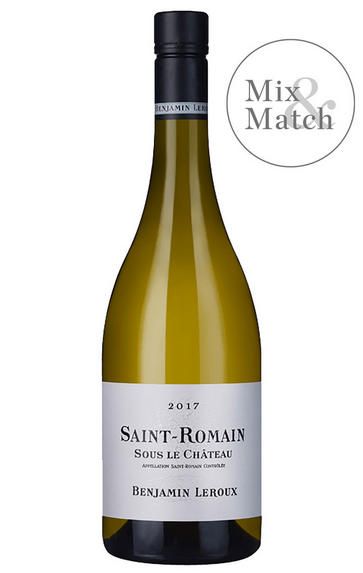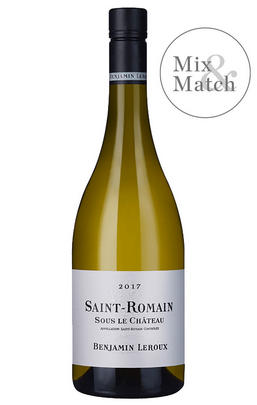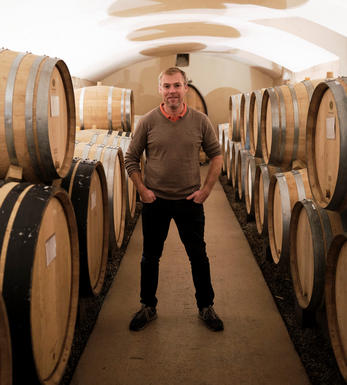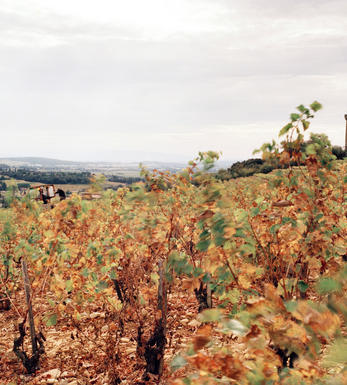
2017 St Romain Blanc, Sous le Château, Benjamin Leroux, Burgundy

About this WINE

Benjamin Leroux
Having created a name for himself as régisseur (general manager) of Domaine du Comte Armand in Pommard, Benjamin Leroux established, with English backing, a small négociant business based in Beaune since 2007. The range is confined to the Côte d’Or, from Chassagne-Montrachet to Gevrey-Chambertin, with the intention of developing farming contracts or indeed purchasing vineyards in the future.
The possibilities are very exciting for this exceptionally talented vigneron. Benjamin is a master at delivering purity of fruit alongside a seamless texture in his wines which have only the subtlest influence of oak. One of Benjamin’s favourite locations for white wine vineyards is the border between Auxey-Duresses and Meursault, which is where Les Vireuils can be found. Here the natural weight of Meursault is enhanced by the fresher minerality typical of the side valley of Auxey-Duresses.
Jasper Morris MW, Burgundy Wine Director and author of the award-winning Inside Burgundy comprehensive handbook.
Discover the story behind our Own Selection Bourgogne Côte d’Or Pinot Noir, made for us by Benjamin. Read more

Bourgogne Blanc
Bourgogne Blanc is the appellation used to refer to generic white wines from Burgundy, a wide term which allows 384 separate villages to produce a white wine with the label ‘Bourgogne.’ As a result of this variety, Bourgogne Blanc is very hard to characterise with a single notable style, however the wines are usually dominated by the presence of Chardonnay, which is just about the only common factor between them. That being said, Chardonnay itself varies based on the environmental factors, so every bottle of Bourgogne Blanc will vary in some way from the next! Pinot Blanc and Pinot Gris are also permitted for use in Bourgogne Blanc under the regulations of the appellation.
As Bourgogne Blanc is very much an entry-level white wine for most regions in Burgundy, prices are usually very reasonable, and due to the terroir and climate of Burgundy, Bourgogne Blanc wines tend to have a strong acidity to them, combined with a vibrant and often fruity palate when compared with other whites from the New World, say, allowing fantastic matchmaking with many different kinds of food.

Chardonnay
Chardonnay is often seen as the king of white wine grapes and one of the most widely planted in the world It is suited to a wide variety of soils, though it excels in soils with a high limestone content as found in Champagne, Chablis, and the Côte D`Or.
Burgundy is Chardonnay's spiritual home and the best White Burgundies are dry, rich, honeyed wines with marvellous poise, elegance and balance. They are unquestionably the finest dry white wines in the world. Chardonnay plays a crucial role in the Champagne blend, providing structure and finesse, and is the sole grape in Blanc de Blancs.
It is quantitatively important in California and Australia, is widely planted in Chile and South Africa, and is the second most widely planted grape in New Zealand. In warm climates Chardonnay has a tendency to develop very high sugar levels during the final stages of ripening and this can occur at the expense of acidity. Late picking is a common problem and can result in blowsy and flabby wines that lack structure and definition.
Recently in the New World, we have seen a move towards more elegant, better- balanced and less oak-driven Chardonnays, and this is to be welcomed.


Buying options
Add to wishlist
Description
This wine is one of Benjamin Leroux’s personal favourites; he believes that it marries the geology of the Côte de Beaune with the freshness of the Hautes-Côtes. The result is a wine which is at once ripe and incredibly fresh. This 2017 vintage is excellent; it’s notable for its freshness and purity, and for its beautifully spicy, struck match finish. It’s lovely.
Drink now to 2025
Adam Bruntlett, Burgundy Buyer (October 2020)
wine at a glance
Delivery and quality guarantee